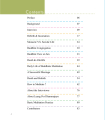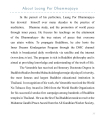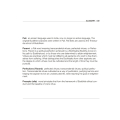Buddhist publications : ค้นหาหนังสือธรรมะ หน้า 5 / 52
หน้าหนังสือทั้งหมด

72
Understanding Vinaya: The Code of Conduct in Buddhism
'Vinaya' means 'code of conduct', 'discipline' and 'regulations'on the behaviour of individuals. As a collection, it is the name of the first portion of the Buddhist Canon [Vinaya-piṭaka] which deals
Vinaya refers to the code of conduct governing the behavior of individuals within the Buddhist community, particularly monks and nuns. It encompasses the Vinaya-piṭaka, the first portion of the Buddhi

125
Understanding Key Buddhist Concepts
"Fools" (palay): spiritually defective people. A fool is someone wicked, weak, or feeble in a moral sense. His discretion is faulty, not knowing right from wrong, good from bad. A fool is one who give
This content delves into various Buddhist concepts such as 'fools'—spiritually defective individuals whose actions reflect moral weakness. It explains that heaven in Buddhism comprises six levels prov

56
Concepts in Buddhist Terminology
สังขาร (sankhara) compounded things; component things; conditioned things; kamma formations; mental formations; mental predispositions; essential conditions; conductive factors; conception; notion; th
Text discusses various Buddhist terms and concepts including 'สังขาร' (sankhara) which refers to conditioned things and mental formations. It details the concept of 'สังสาร' (samsara) as the cycle of

3
Analyzing the Dhammacakkappavattana Sutta: A Text-Critical Approach
The Document Research Methods
Case Study: The Dhammakakkappavattana Sutta
Pramaha Pongsak THANIO
Abstract
Dhammacakkappavattana Sutta (Sanskrit: Dharmacakaravartana
Sutra) is regarded as one of the
The Dhammacakkappavattana Sutta, a key Buddhist text, shows multiple versions arising after the Buddha’s death, raising authenticity questions. This research employs text-critical methods to establish

30
Vinayapitaka Editions and References
Vinayapitaka vol.IV. 2001. edited by Hermann Oldenberg. Oxford:
PTS. (first printed. 1882)
Vinayapitaka vol.V. 2006. edited by Hermann Oldenberg. Oxford:
PTS. (first printed. 1883)
อ้างอิงอื่น ๆ
PT
Vinayapitaka editions include volumes IV and V, edited by Hermann Oldenberg, published by the Pali Text Society with first prints in 1882 and 1883 respectively. Other important references include Nori

6
Exploring Early Buddhist Schools: Pāli and Chinese Connections
considered to have already appeared in the early Buddhist schools (Hinayāna) period at the latest and to have been widely recognized by at least two schools in company of them.
Throughout a study of t
This study examines the connections between Pāli and Chinese stanzas through early Buddhist schools, specifically focusing on: (1) Two Pāli stanzas aiding the understanding of Chinese transliterated t

4
The Role of Garudhamma in Buddhist Nuns' Conduct
a misplaced doubt about the rule that a nun must be given advice (ovāda)
and pointed out her bad behaviors (pavāraṇā) by a monk. Based on the
evidence in the Pāli canon, I make a clearer definition an
This paper examines the role of garudhamma in guiding the conduct of Buddhist nuns, highlighting their importance as norms rather than customs. It discusses the issues raised by a monk regarding advic

190
Maintaining Buddhism Amidst Crisis
When people lose their faith in Buddhism, they do not
teach their children to pay respect to the monks. They show
no interest in studying Buddhist teachings and stop making
merit. All temple activitie
When faith in Buddhism wanes, respect for monks declines, leading to a stagnation of temple activities. Negative portrayals of monks can mislead the public; thus, critical thinking is essential. The S

43
Scholarly Works on Buddhism and Sanskrit
TUBB, Gary A., and Emery R. BOOSE.
2007 Scholastic Sanskrit: A Manual for Students. New York:
Columbia University Press.
WILLEMEN, Charles, Bart DESSEIN and Collett Cox.
1998 Sarvāsτivāda Buddhist S
This JSON entry encompasses notable academic publications focusing on Sanskrit and Buddhist studies. Essential readings include Gary A. Tubb's guide for students on Scholastic Sanskrit, a comprehensiv

6
Clear-minded Youths: The Dhamma for Teenagers
Preface
Clear-minded Youths (The Dhamma for teenagers) has 6 stories about Buddhist children in Lord Buddha Period. There are Buddhist and non-Buddhist children.
For studied about how to build the r
Clear-minded Youths (The Dhamma for teenagers) presents six engaging stories about Buddhist and non-Buddhist children from the Lord Buddha's era. The book aims to cultivate religious faith among child

4
Exploring Buddhism: Key Insights and Practices
4
Contents
Preface
Background
Interview
06
07
09
Rebirth & Incarnation
17
Monastic V.S. Secular Life
24
Buddhist Congregation
30
Buddhist View on Sex
33
Death & Afterlife
39
Daily Life of Buddhists Me
This content provides an overview of significant topics in Buddhism such as the concepts of rebirth and incarnation, the differences between monastic and secular life, and the Buddhist perspective on

77
Luang Por Dhammajayo: A Path to Inner Peace
About Luang Por Dhammajayo
In the pursuit of his perfection, Luang Por Dhammajayo
has devoted himself over many decades to the practice of
meditation, Dhamma study, and the promotion of world peace
th
Luang Por Dhammajayo has dedicated decades to meditation and Dhamma study, promoting inner peace as a way to achieve world peace. He teaches the Dhammakaya, the essence of true peace accessible to all

48
The Golden Age of Inner Peace
Golden Age of Inner Peace
the World No Tobacco Day Award in 2004 from
the World Health Organisation for his successful
smoke-free campaign among hundreds of Buddhist
temples in Thailand. He was the fi
This text outlines the achievements of a Thai Buddhist monk who received multiple prestigious awards for his dedication to promoting inner peace and smoke-free environments in Thailand's Buddhist temp

5
Understanding Kamma and Buddhist Practices
The event begins after Buddhist Lent and continues for one month.
กรรม kamma; karma; action; deed; willed action; an intentional action that has future consequences, including future reboots; th
This text delves into the fundamental concept of kamma (karma) in Buddhism, emphasizing that every intentional action we perform leads to future consequences. The Buddha defines kamma as volition (cet

163
Understanding Pali and Parami in Buddhism
Pali: an ancient language used in India, now no longer an active language. The original Buddhist scriptures were written in Pali. Pali texts are used by the Theravada school of Buddhism.
Parami: a Pa
Pali is an ancient language from India that is no longer actively spoken but holds significant historical importance as the original language of Buddhist scriptures. These scriptures serve as a core e

566
หลักฐานธรรมภายในคัมภีร์พุทธโบราณ
หลักฐานธรรมภายในคัมภีร์พุทธโบราณ 1 ฉบับวิชาการ
Hirakawa, Akira, and Paul Groner. 1990. *A History of Indian Buddhism*. From Sakyamuni to Early Mahayana, Asian studies at Hawaii.
Honolulu: University
งานวิจัยนี้นำเสนอหลักฐานทางธรรมจากคัมภีร์พุทธโบราณ โดยอ้างอิงงานวิจัยและเอกสารสำคัญในประวัติศาสตร์พุทธศาสนา เช่น งานของ Hirakawa และ Hoernle ซึ่งให้ข้อมูลเชิงลึกเกี่ยวกับพุทธศาสนาในภูมิภาคต่าง ๆ ในช่ว

564
หลรรษฐานธรรมาภายในคัมภีร์พุทธโบราณ 1 ฉบับวิชาการ
หลรรษฐานธรรมาภายในคัมภีร์พุทธโบราณ 1 ฉบับวิชาการ
Gernet, Jacques. 1996. A History of Chinese Civilization. 2nd ed.
Cambridge: Cambridge University Press.
Glass, Andrew, and Mark Allon. 2007. Four Gāṇ
เอกสารนี้นำเสนอการศึกษาคัมภีร์พุทธโบราณและวรรณกรรมที่มีชื่อเสียง อาทิ การวิเคราะห์และพิจารณาเอกสารด้านพุทธศาสตร์ เช่น Sūtras และ Manuscripts ที่มีความสำคัญในด้านการศึกษาและประวัติศาสตร์ของพุทธศาสนา อ้

5
Luang Por Dattajevo: A Visionary in Thai Buddhism
Luang Por Dattajevo (monastic name Phrabhavanaviriyakhun) is a Thai Buddhist monk who was born in 1941, in Kanchanaburi, Thailand. He was educated within the public school system of Thailand and went
Luang Por Dattajevo, born in 1941 in Kanchanaburi, is a notable Thai Buddhist monk and educator. After receiving a post-graduate degree in Australia, he helped establish Wat Phra Dhammakaya in 1970 an

182
Characteristics of a True Buddhist
are like any of them and if we have performed our duties as true Buddhists yet or not.
A true Buddhist must exhibit the following characteristics:
1) Belief in the Lord Buddha’s Enlightenment. It is
This text outlines the defining characteristics of a true Buddhist, emphasizing belief in the Lord Buddha's Enlightenment, adherence to the 5 precepts, understanding the Law of Kamma, and maintaining

184
Dhammakaya Temple and the Challenge of Abandoned Temples in Thailand
Of course, people closely followed the news about the Temple. After two years, the outcome was the reverse. Unbelievably, the Temple has survived to this day. Many said that in the same period of time
The Dhammakaya Temple has remarkably survived against media backlash, drawing nearly 100,000 attendees to its ceremonies, despite allegations of bribery. Meanwhile, a concerning trend of temple abando
